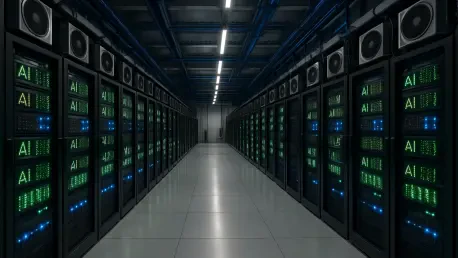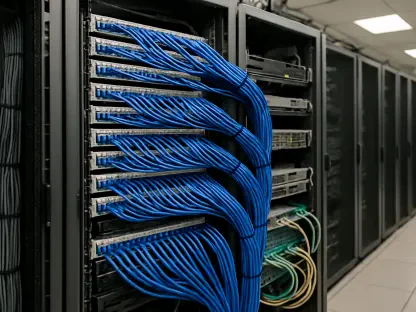Setting the Stage for AI-Driven Transformation
The data center industry stands at a critical juncture in 2025, with artificial intelligence (AI) workloads surging to unprecedented levels, commanding over 75% of new projects. This seismic shift is not merely a trend but a fundamental redefinition of digital infrastructure, pushing the boundaries of computational power and energy demands. As industries race to harness AI for innovation, the pressing question looms: can data centers evolve fast enough to support this technological revolution while grappling with power constraints and sustainability goals?
This review dives deep into the current state of AI-driven data center workloads, exploring the cutting-edge technologies that power them, their real-world impact, and the challenges that threaten to slow progress. By dissecting the core components and emerging trends, this analysis aims to shed light on how AI is reshaping the backbone of the digital economy.
Core Features and Performance Analysis
High-Density Computing as the New Standard
AI workloads differ vastly from traditional cloud computing tasks, demanding immense processing power that has spurred a shift to high-density computing environments. These setups, characterized by densely packed servers and specialized hardware like GPUs, are engineered to handle the intensive calculations required for machine learning and large-scale analytics. The performance metrics speak volumes: high-density systems enable faster data processing and scalability, critical for meeting the demands of modern AI applications.
However, this transition is not without hurdles. Infrastructure must be meticulously designed to support such density, requiring robust power delivery systems and advanced hardware configurations. As data centers pivot to accommodate these needs, the focus on optimizing space and energy efficiency becomes paramount, setting a new benchmark for operational excellence.
Liquid Cooling Systems for Thermal Management
One of the standout innovations in managing AI workloads is the adoption of liquid cooling systems, a stark departure from outdated fan-based methods. With AI hardware generating significant heat, liquid cooling offers superior efficiency by directly absorbing thermal output, ensuring stable performance under heavy loads. Approximately 53% of industry stakeholders anticipate this technology becoming dominant in high-density projects due to its ability to handle extreme conditions.
The trade-off lies in cost, with liquid cooling carrying a 7-10% premium over traditional systems in the US market. Despite this, the environmental benefits are notable, particularly with closed-loop designs that minimize water usage and align with regulatory expectations in water-scarce regions. This technology represents a critical step toward balancing performance with ecological responsibility.
Power Availability and Site Selection Dynamics
Power availability emerges as a defining factor in the deployment of AI-optimized data centers, with grid connection delays impacting nearly half of industry players. The competition for electricity, spanning multiple sectors, has intensified in key growth hubs across the US and Europe, often dictating site selection over other considerations like cost. This shift underscores the urgent need for infrastructure that can keep pace with escalating energy demands.
Innovative strategies are slowly gaining traction to address these constraints. A small fraction of operators, roughly 14%, are exploring on-site power generation or renewable energy integration to support AI loads. While still in early stages, such approaches hint at a future where data centers might reduce reliance on strained grids, paving the way for more resilient operations.
Real-World Impact and Industry Applications
AI workloads are revolutionizing data center applications across diverse sectors, from technology to finance and healthcare, where specialized facilities are becoming indispensable. In tech hubs, these centers power complex machine learning models, while in healthcare, they enable rapid analysis of vast datasets for medical research. This versatility highlights AI’s role as a cornerstone of digital transformation.
Geographically, regions like the US and Europe are witnessing a boom in AI-optimized facilities, driven by robust demand for cutting-edge infrastructure. These hubs serve as testing grounds for advanced deployments, showcasing how tailored data centers can meet specific industry needs. The ripple effect is clear: as adoption spreads, the blueprint for future facilities is being redrawn.
Unique use cases further illustrate the transformative potential of AI-driven centers. From supporting real-time analytics for financial trading to enabling predictive modeling in logistics, the applications are as varied as they are impactful. Such examples underscore the technology’s capacity to drive innovation, even as deployment challenges persist.
Challenges Hindering Scalability
Despite the promise of AI workloads, significant barriers loom large, starting with power constraints that delay project timelines. Grid infrastructure often lags behind the rapid pace of data center construction, creating bottlenecks that frustrate speed-to-market goals. This issue remains a top concern, as reliable electricity is non-negotiable for high-density operations.
Supply chain uncertainties compound the problem, with confidence in supplier reliability for critical components like switchgear remaining low—only 19% expect timely deliveries in the coming year. Additionally, a mere 17% of stakeholders believe the industry is prepared with the technical expertise needed for advanced cooling systems. These gaps signal a pressing need for workforce development and supply chain stabilization.
Cost dynamics present another layer of complexity, with construction expenses for traditional centers rising by 5.5% per watt through the current year. High-cost regions face even steeper challenges, where building AI-ready infrastructure can exceed $14 per watt. Balancing these financial pressures with sustainability goals and rapid deployment timelines creates a delicate tension for operators.
Emerging Trends Shaping the Future
Looking ahead, projections indicate that AI workloads will dominate over half of data center activities within the next two years, signaling a profound shift in industry focus. This trajectory suggests that by 2027, AI-optimized centers could account for a substantial share of the global market. Such growth demands continuous innovation in design and technology to keep pace.
Sustainability is gaining attention, though adoption of green practices remains uneven. Closed-loop cooling systems offer environmental benefits, yet many facilities still rely on water-intensive methods. The push for renewable energy and microgrid development is evident, but broader implementation is needed to align with long-term ecological targets.
Site selection strategies are also evolving, with power availability increasingly dictating location choices. Developers are exploring creative solutions, such as funding renewable deployments or leveraging natural gas turbines, to mitigate grid dependency. These trends point to a future where adaptability and resourcefulness will define success in the AI data center landscape.
Reflecting on the Journey and Next Steps
Looking back, the rapid integration of AI workloads into data center operations marked a turning point for the industry, highlighting both remarkable advancements and persistent obstacles. The shift to high-density computing and liquid cooling addressed critical performance needs, while power and cost challenges tested the sector’s resilience. Each step forward revealed the complexity of scaling infrastructure for an AI-driven world.
Moving into the future, actionable solutions must prioritize energy innovation, with a focus on expanding on-site power generation and microgrid systems to alleviate grid strain. Collaborative efforts between operators, utilities, and policymakers could accelerate infrastructure upgrades, ensuring reliable electricity for burgeoning demand. Investing in technical training for advanced cooling expertise will also be crucial to bridge readiness gaps.
Beyond immediate fixes, the industry should commit to sustainability as a core principle, integrating renewable energy at scale to reduce environmental impact. By fostering partnerships and embracing adaptive strategies, data centers can transform challenges into opportunities, ensuring they remain the robust foundation of the digital age.









